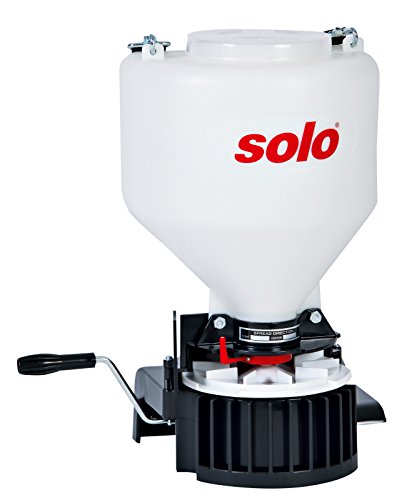Basically, two spreader equipment options are available for distributing crabgrass preventer, lawn fertilizer or turf seed.
Neither spreader is better or cheaper to use than the other; both are available to buy or rent. Choosing between them is just a matter of experience and opinion.
One spreader drops granules or seeds directly to the ground beneath its wheels.
The other houses a rotary mechanism that broadcasts the lawn input out over a broader area.
Typically, both have wheels and a handle, and they go into action when pushed.
Either spreader is a better choice than trying to distribute things by hand. Even when you’re treating or renovating small areas, a little handheld version of the rotary spreader will do a better job than trying to distribute an application by hand.
One tricky part about operating a push-type spreader is that it will produce best results only if the operator can maintain a steady walking pace and walk straight.
If possible, start on a side of the lawn that’s already a straight line – the kind of edge you find next to sidewalks, driveways, streets and fences. As you go, your spreader’s wheels will leave lines of mashed grass that you can use as a guide for your next pass. Seeing where you have already walked will be easiest if you make your application when there is some dew on the grass.
After you have covered the lawn completely once, you may need to make changes to the spreader setting, so that your second pass will uniformly cover the lawn without running out of material while in the middle of your yard. Crisscrossing the lawn in more than one direction helps you achieve a more even distribution.
Homeowners most often choose to use a drop spreader because they’ll always know exactly where the preventer, fertilizer or seed is going – directly between the spreader’s wheels.
On your second pass, you have to overlap the closest wheel mark left behind by the first pass. That ensures material gets distributed onto the wheel mark’s bent-over grass, plus keeps you going straight. Then you have to do the same with each subsequent pass, overlapping the outside wheel mark from the preceding pass.
Overlapping incorrectly can be embarrassingly obvious after applying fertilizer. Missed wheel marks will turn yellow-green. Overlaps that go too far, fertilizing a small area twice, will soon show up as an unusually dark green stripe.
Professional landscapers often choose a broadcast or rotary spreader in order to cover a lot of ground quickly. The material drops from the hopper onto a whirling disc that flings it out over a much larger area. The operator’s walking pace helps determine how far the material goes, along with the material’s size, weight and shape.
You’re not as likely to create stripes with this spreader, unless the spreader setting and application rate are too high. If you don’t know what you’re doing or get distracted, though, you still can over- or under-apply material. You also can fling granules all over the place, including onto streets and sidewalks. Those that land on a hard surface can end up in the stormwater drainage system and eventually streams and lakes as soon as it rains. So, you should sweep or blow any material that lands in the street, sidewalk or driveway back onto the lawn.
To do a good job, rotary-spreader operators must be particularly careful to maintain a steady pace. At the same time, they must stay aware of the material’s spread width and the previous pass’ wheel marks. That’s important because the farther from the spreader, the thinner the application is. So, you have to walk in a straight line and overlap your swaths of distributed material. Product bags typically suggest you overlap by 6 to 10 inches, and that’s fine.
To ensure uniform coverage, lower the spreader’s setting to about one-fourth of what the bag recommends and then apply the material in a pattern called ‘wheel track–to-wheel track and in two directions.’ Basically, that’s overlapping close enough that the last few particles you’re putting down are landing between the previous path’s wheel tracks. That essentially doubles the amount you’re applying, After that, you repeat the process in a second direction, which again doubles the application rate.
No matter their preferred application pattern, broadcast-spreader operators must be especially careful to stop the equipment whenever turning or reaching the edge of the lawn. Otherwise, they can end up whirling seed onto a flower bed or flinging fertilizer onto a neighbor’s patio furniture.
Operators should practice first if they’ve never used a particular rotary spreader or product. The driveway or a big garage is a good place to practice, because you can sweep up and weigh the material you distribute in your practice run to calibrate that product and spreader to your lawn. You’ll also be able to see how far away from your straight lawn edge you’ll need to be when you make your first pass, so you won’t waste fertilizer, plant protection products or seed.


